The Big and Small of Rockets

The Saturn V rocket.
From the acidic digestive fluid in your stomach to the dry, cratered surface of Mars, rockets could soon make it possible to explore extreme environments as never before.
The Big
If all goes according to plan, NASA's proposed Space Launch System (SLS) will blast astronauts off of the Earth and toward asteroids, the moon, and maybe even Mars within the next two decades. In late 2011 NASA announced the design for this long-awaited successor to Saturn V, the rocket that carried man to the moon. Like the Saturn V rocket, the SLS will use a liquid propulsion system to escape the pull of the Earth's gravity. However, the SLS will be even more powerful than the Saturn V and will take humans deeper into space than ever before.
Getting astronauts off of this planet and onto another requires an enormous amount of force. The force that propels rockets into space is called thrust, and is created by a chemical process that takes place inside the engines of a rocket. In a liquid-fueled engine, which is likely to form the main engine of the SLS, the process begins when a fuel (like liquid hydrogen) and an oxidizer (like liquid oxygen) are pumped into an empty chamber. The two interact, causing a powerful chemical reaction that creates high pressured streams of fast moving gas. The gas is forced down into a nozzle where it is accelerated even more and spews out as exhaust at speeds up to 10,000 mph.
One of the fundamental physics principles that guides rocket design is Isaac Newton's third law: For every action there is an equal and opposite reaction. As the exhaust from a rocket pushes down toward the launch pad, the reaction force, or thrust, propels the rocket upward. The amount of force depends on how much fuel is burned and its acceleration out of the engine, in accordance with Newton's second law (force equals mass times acceleration). Therefore, a rocket headed for Mars will need to burn a lot more fuel and/or expel it much more quickly than one bound for low-Earth orbit.
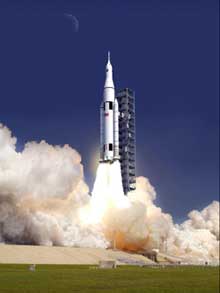
An artist concept of SLS launching. (NASA)
Like the Space Shuttle, the SLS will be a multi-stage rocket with a series of engines and propellants that all work together to create maximum thrust. However, the SLS will be much more powerful. The Space Shuttle was designed to get humans into low-Earth orbit, but the SLS is designed to get people outside of the Earth's orbit altogether.
The Small
On the other end of the scale, a group of researchers at the University of California, San Diego are working with a tiny, self-propelled rocket that could revolutionize drug delivery to the human body. The rocket is called "micro" because in contrast to the SLS that is expected to be well over 100 meters tall when fully complete, the microrocket is just 10 microns long (a micron is 0.000001 meters).
Microrockets have their own engineering challenges, but are not nearly as complex as the SLS. The body of a microrocket is shaped like a tube and made out of a polymer called polyaniline. The inside of the tube is coated with a thin layer of zinc. They look pretty different from space-bound rockets, but microrockets are affectionately called "rockets" because they can travel surprisingly fast. They are also great illustrations of Newton's third law in action.
When you place one of these microrockets in an acidic solution, like digestive fluid, the zinc in the rocket reacts with the acid in a person's digestive tract and creates bubbles. These bubbles are expelled from one end of the tube and, as predicted by Newton's third law, the tube takes off in the opposite direction. Initial tests showed a microrocket traveling more than one hundred times its body length per second. That is roughly equivalent to a car traveling one mile in less than four seconds!
In addition, the researchers were able to control the movement of the rocket and even pick-up, carry, and release an object using magnetic forces. To do this they added a thin layer of magnetic material to the outside of the tube and directed the microrocket by rapidly changing the external magnetic field.
The research team, led by Joseph Wang, is still optimizing the design, but “rockets” like these have many potentially revolutionary applications, ranging from targeted drug delivery to measuring changes in the pH of an extreme environment or performing quality control checks on acidic solutions used for industrial processing.
In the last few years scientists have been working earnestly to create nano- and micro-sized motors, but this is the first demonstration of one that is self-powered by a chemical reaction. In most cases the motors require that a particular fuel, such as hydrogen peroxide, be added to the solution in which they are moving.
Stay tuned—whether bringing humans to Mars or medicine to a specific area of an individual's stomach, rockets hold a lot of promise for the future!
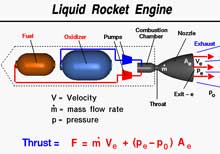 A simplified diagram of a liquid rocket engine. NASA) |
 A Saturn V rocket streaks toward space on the night of December 17, 1972, carrying the Apollo 17 crew, the last astronauts to explore the Moon. (NASA) |
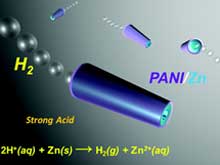 A schematic of microrocket motion in an acidic environment. Reprinted with permission from: Hydrogen-Bubble-Propelled Zinc-Based Microrockets in Strongly Acidic Media Wei Gao, Aysegul Uygun, and Joseph Wang Journal of the American Chemical Society 2012 134 (2), 897-900. Copyright 2012 American Chemical Society. |
For more information on how rockets work, microrockets, and the Space Launch System, check out these resources:
How Stuff Works: How Rocket Engines Work
Learn how thrust, fuel, and the other physics principles make rockets go.
PhysOrg.com: Bubble-propelled microrockets could operate in the human stomach
Read a summary of the journal article and some comments from the University of California researchers.
Journal of the American Chemical Society: Hydrogen-Bubble-Propelled Zinc-Based Microrockets in Strongly Acidic Media
Take a look at the journal article announcing the zinc-based microrockets and their performance results. Note: Subscription or fee required.
The New York Times: NASA Unveils New Rocket Design
Find out more about the Space Launch System and the motivation for the new design.
NASA: The Space Launch System
Find the latest news and features about NASA's Space Launch System.
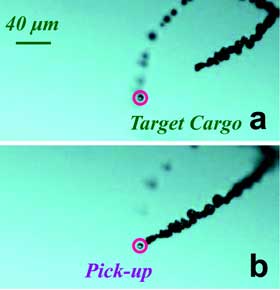 |
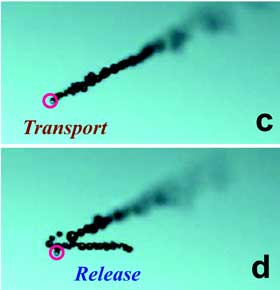 |
| Time-lapse images of a microrocket (5 μm diameter) approaching (a), capturing (b), transporting (c), and releasing (d) the 5 μm target sphere. Reprinted with permission from: Hydrogen-Bubble-Propelled Zinc-Based Microrockets in Strongly Acidic Media Wei Gao, Aysegul Uygun, and Joseph Wang Journal of the American Chemical Society 2012 134 (2), 897-900. Copyright 2012 American Chemical Society. |
|














